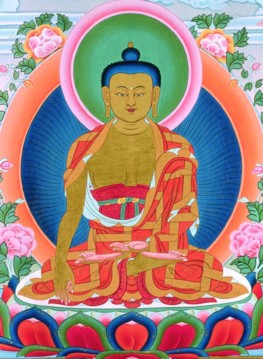Buddha Shakyamuni
(Redirected from Shakyamuni)

Buddha Shakyamuni (Skt. Śākyamuni; Tib. སངས་རྒྱས་ཤཱཀྱ་ཐུབ་པ་, Wyl. sangs rgyas shAkya thub pa) — the Indian prince Gautama Siddhartha, who reached enlightenment (and thus became a buddha) in the sixth century B.C., and who taught the spiritual path followed by millions all over the world, known today as Buddhism.
Dates
Dates for the parinirvana according to:
- 2420 B.C.E. the Pandita Sureshamati
- 2150 B.C.E. the rGya-bod-yig-tshang
- 2146 B.C.E. Üpa Losal
- 2136 B.C.E. Atisha
- 2133 B.C.E. Sakya Pandita
- 949 B.C.E. The Blue Annals refering to a Chinese tradition from Fo-lin and accepted by the Japanese schools: Jodo, Jodo-Shinshu and Nichirenshu
- 881 B.C.E. Pakpa Lhundrup (followed by Butön and Dudjom Rinpoche)
- 876 B.C.E. Butön based on the Kalachakra tantra
- 835 B.C.E. Jonangpa school scholars
- 750 B.C.E. Tshalpa Kunga Dorje, based on the history of the Sandalwood Buddha
- 718 B.C.E. Kamalashila
- 651 B.C.E. Orgyenpa
- 544/543 B.C.E. Shakyashri, last abbot of Vikramashila
- 544 B.C.E. Theravadin tradition
- 489 B.C.E. based on the reign of Ashoka being 218 years after the parinirvana
- 486 B.C.E. "dotted record" which came to China through Samghabhadra
- 483 B.C.E. some modern scholars (an adjustment to the "dotted record")
- 386/383 B.C.E. modern Japanese scholars
- 371 B.C.E. based on the reign of Ashoka being 100 years after the parinirvana
Disciples
Epithets
There are many epithets for the Buddha. The Amarakosha lists them as follows:
- Omniscient One, Gone to Bliss (Skt. Sugata), Awakened One, King of Dharma, Thus Gone One (Skt. Tathāgata),
- Always Good, Blessed Lord (Skt. Bhagavan), Victor over Māra, Victor of the World, Victorious One,
- Possessor of Six Super-Knowledges, Possessor of Ten Strengths, Speaker of Non-Duality, Remover of Obstacles,
- King of Sages, Full of Glory, Teacher, The Sage, Sage of the Śākyas,
- Lion of the Śākyas, Accomplisher of All Aims, Son of Śuddhodana,
- Gautama, Kinsman of the Sun, Son of Māyādevī.[1]
Traditional Biographical Sources
Further Reading
- Dzongsar Jamyang Khyentse, What Makes You Not a Buddhist (Boston & London: Shambhala, 2007)
- Sir Edwin Arnold, The Light of Asia
- Thich Nhat Hanh, Old Path White Clouds (Berkeley: Parallax Press, 1991)
- Tulku Thondup, Masters of Meditation and Miracles, edited by Harold Talbott (Boston: Shambhala, 1999), 'Shākyamuni Buddha'.
Oral Teachings Given to the Rigpa Sangha
- Dzogchen Rinpoche, Buddha’s Life and Path of Liberation, Lerab Ling, 6-7 June 1998
- Dzogchen Ponlop Rinpoche, Lerab Ling, 9 September 2011
- Dominique Side, Melbourne, Australia, 21-22 October 2017
- Philippe Cornu, Rigpa centre, Levallois, 4 November 2019
- Ringu Tulku Rinpoche, Sikkim, India, June/July 2020: The Life of the Buddha: Heart Lessons, available as video on demand here
Notes
- ↑ The Sanskrit is as follows:
- sarvajñaḥ sugato buddho dharmarājastathāgataḥ
- samantabhadro bhagavān mārajillokajijjinaḥ
- ṣaḍabhijño daśabalo 'dvayavādī vināyakaḥ
- munīndraḥ shrīghanaḥ shāstā muniḥ śākyamunistu yaḥ
- saḥ śākyasiṃhaḥ sarvārthasiddhaḥ śauddhodaniśca saḥ
- gautamaścārkabandhuśca māyādevīsutaśca saḥ
- བདེ་གཤེགས་སངས་རྒྱས་ཐམས་ཅད་མཁྱེན། ། ཆོས་ཀྱི་རྒྱལ་པོ་དེ་བཞིན་གཤེགས ། །
- ཀུན་ཏུ་བཟང་པོ་བཅོམ་ལྡན་འདས། །བདུད་འདུལ་འཇིག་རྟེན་རྒྱལ་བ་པོ། །
- མངོན་ཤེས་དྲུག་ལྡན་སྟོབས་བཅུ་པ། །གཉིས་མེད་གསུངས་རྔུ་དང་རྣམ་པར་འདྲེན། །
- ཐུབ་པའི་དབང་པོ་དཔལ་སྟུག་དང་། །སྟོན་པ་ཐུབ་པ་ཉིད་རྣམས་སོ། །
- ཤཱཀ་ཐུབ་ཤཱཀྱའི་སེང་གེ་དང་། །དོན་རྣམས་གྲུབ་པ་ཟས་གཙང་སྲས། །
- གོ་ཏ་མ་དང་ཉི་མའི་གཉེན། །ལྷ་མོ་སྒྱུ་འཕྲུལ་སྲས་རྣམས་སོ།
Internal Links
- Mantra of Buddha Shakyamuni
- Twelve deeds
- Two images of Buddha Shakyamuni
- Quotations: Sutras, a collection of quotations from different sutras.